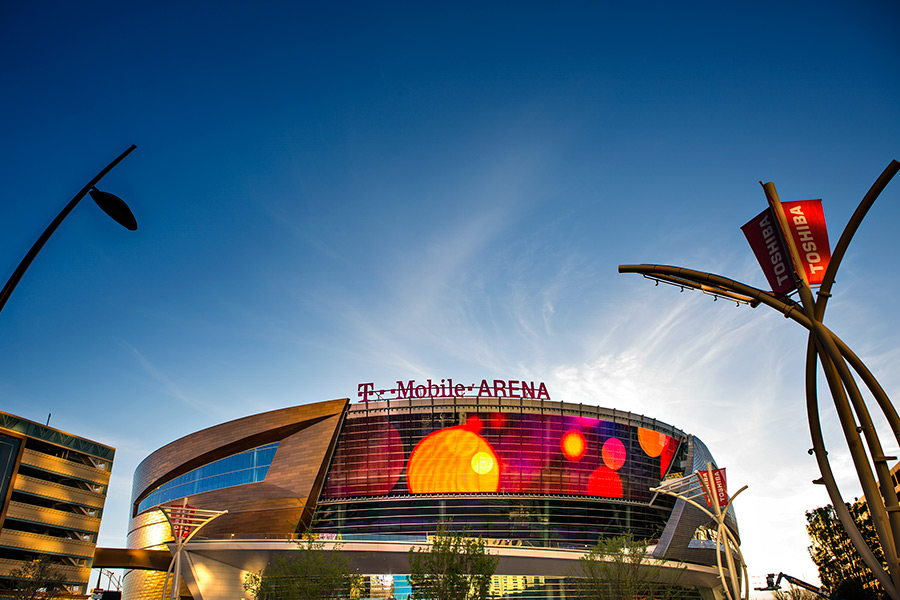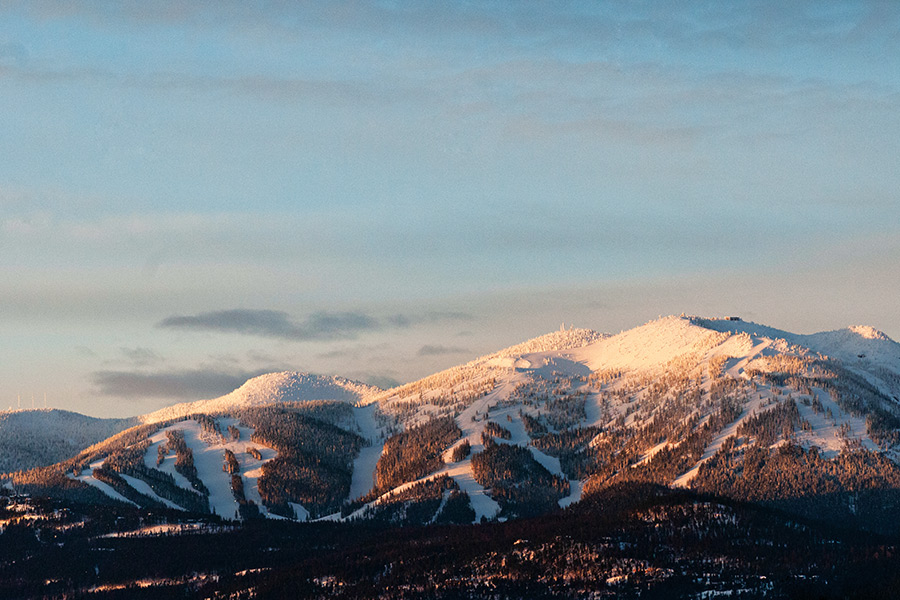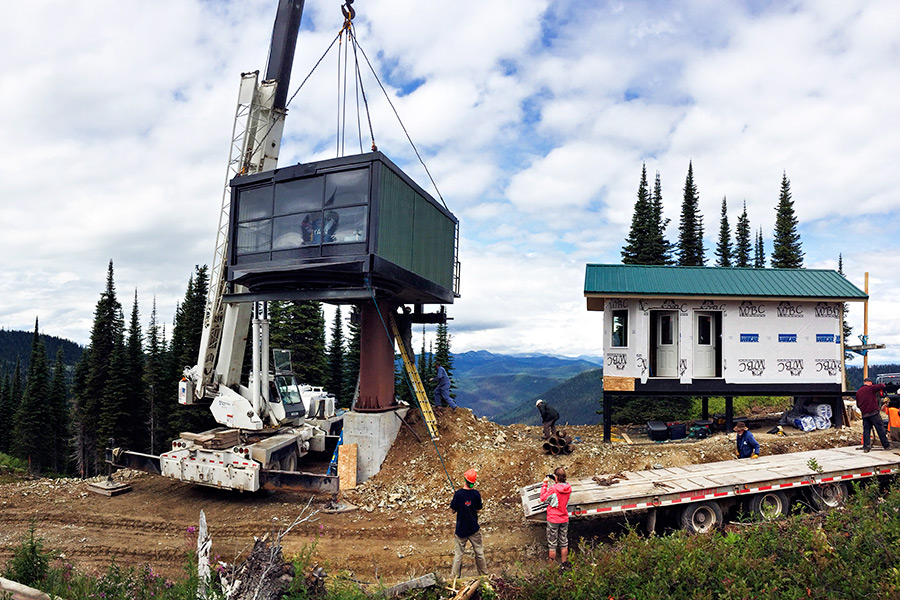WHITEFISH — Last week inside his cozy office along Wisconsin Avenue, Bill Foley listened to morning presentations from two of the world’s largest apparel companies about his new business venture, an NHL team in Las Vegas.
Representatives from each of the major corporations were helping Foley decide the name and colors that would brand his nascent franchise, which was officially approved by the NHL’s Board of Governors and announced June 22 by Commissioner Gary Bettman.
Foley had appeared in Las Vegas to mark the milestone after two-and-a-half years of trying to bring the first professional sports franchise to the so-called Entertainment Capital of the World. The expansion team will hit the ice in the 2017-18 season at the new T-Mobile Arena, a 17,500-seat state-of-the-art entertainment facility that opened in April.
In the immediate aftermath, Foley departed the blistering Nevada desert and arrived in Montana with his wife of over 40 years, Carol. He took a few days to relax and played golf at his exclusive club and resort, the Rock Creek Cattle Company outside Deer Lodge, before traveling west to his home and office in the mountains of the Flathead Valley, his go-to refuge the past 10 years.
It was here that he began to go over the finer details of the franchise, including hiring upper management and settling on a name for the organization. Foley wanted the Black Knights, uniformed in black, gold and gray in homage to the United States Military Academy. He graduated from West Point in 1967 and frequently cites his tenure there as an important turning point that set his life on the course it eventually followed, building Fidelity National Financial into the nation’s largest title insurance company that is a mainstay on the Fortune 500 list.
But as others pointed out last week, the Black Knights and their dark color scheme didn’t seem to fit the identity of Las Vegas, an Air Force town defined by bright shades of red and gold.
The 71-year-old majority owner acquiesced.
“When you look at Las Vegas, it’s desert. There’s a lot of red rocks. There’s different color schemes. There’s different types of names that maybe don’t come to mind right away,” he said in an interview with the Beacon at his Whitefish office.
“But we’ve got to figure this out. There’s a lot of money involved in this.”
Indeed, in the coming weeks Foley must write the NHL a check for $500 million for his new team. And then organize a front office, place scouts around the world and build a roster of players under the league’s $73 million annual salary cap.
With yet another significant venture pulling Foley in yet another direction, many locals are asking: What about Whitefish?

While keeping a relatively low profile, Foley has developed a significant presence in this corner of Montana.
He is the majority owner of Winter Sports Inc., the corporation that owns and operates Whitefish Mountain Resort, one of the valley’s economic staples. The town’s namesake ski area employs 95 year-round staff, a number that balloons to nearly 550 workers, either part-time or full-time, during the peak of winter. With added activities in recent years, the resort employs roughly 225 people in summer.
Foley owns Glacier Restaurant Group, the largest restaurant company in the state with a new headquarters being built in Whitefish. The restaurant group, formed in 2007, includes MacKenzie River Pizza, Craggy Range Bar & Grill, Ciao Mambo, Latitude 48, and now Max & Erma’s, a Midwest chain that was acquired earlier this year with 70 locations and roughly 1,700 employees. Prior to Max & Erma’s, Glacier Restaurant Group had roughly 1,400 employees across 29 locations.
Foley owns Glacier Jet Center, the large facility at Glacier Park International Airport that provides space, maintenance and other services for private aircraft, as well as charter flights. Over the Fourth of July holiday weekend, nearly 40 private jets utilized the center.
Outside of the Flathead Valley, he also owns the Rock Creek Cattle Company, a 30,000-acre working cattle ranch with a private golf course that is consistently ranked one of the best in the West and an exclusive residential development with 90 homes and 260 members.
While Montana plays a big role in his business portfolio, it’s not alone in vying for his attention. A 1967 West Point graduate who recently became one of only 125 people to ever receive a Distinguished Graduate Award from the military academy, Foley is a billionaire magnate with a far-reaching empire. He owns The Foley Food & Wine Society, which oversees a lineup of wineries across California. He remains the executive chairman of the board of directors for Fidelity National Financial and vice chairman of the board for Fidelity National Information Services. He has majority interests in Ceridian Corporation, a leading provider of payroll services, and Remy International, Inc., the largest manufacturer of automotive alternators and starters in the country.
In other words, Foley is devoted to many businesses and interests across the U.S.
In light of this broad portfolio, particularly the new hockey team, murmurs spread throughout town recently that Foley might be pulling out of Whitefish in some form or another.
In some ways, the rumors carried a sense of panic among residents concerned about the ramifications of his departure.
The irony of this sentiment was not lost on Foley.
“Ten years ago, they didn’t want me involved,” he said. “Ten years ago, everyone thought it was bad. Really bad.”

William P. Foley II burst onto the small-town scene in Northwest Montana with his acquisition of Big Mountain ski area.
At the time, the ski area was a publicly traded company — Winter Sports Inc. — owned by shareholders, many of whom were Flathead Valley residents. Shares of the mountain were widely spread out among local families until the late 1980s, when Budget Finance, a Kalispell company owned by Richard A. Dasen, began acquiring large amounts of WSI shares. By the 1990s, Dasen owned roughly a quarter of the corporation. And then in 2004, Dasen was arrested and charged with 14 prostitution-related crimes, eventually serving jail time.
WSI had already begun reducing the number of shareholders through a 1-150 reverse stock split followed by the corporation buying out shareholders with fewer than 150 shares. Facing financial and legal troubles, Dasen began selling off his shares and Foley emerged as the buyer.
By late 2006, Foley had raised his stake in the corporation to 44 percent and successfully lobbied for a reverse stock split that made WSI an “S” corporation, which limited the number of shareholders to 100. In the end, only 37 shareholders remained with Foley owning 60 percent of the ski area.
This series of events led to heightened scrutiny among locals, many of whom saw Foley as a public pariah who was going to drastically impose his will on the ski area and create a wannabe Aspen or Vail.
“It was so silly because it was never going to be that kind of mountain. It’s a blue-collar mountain. It’s not expensive. We keep our ticket pricing down. We go up a little bit but we’ve held certain years,” Foley said. “But if you go to Colorado or Utah, you get killed. You can get a season pass up here for $600 and ski as much as you want. I never had a thought of making it exclusive. It was silly. But I think everyone has gotten over it. I think they’re over it now.”
Mike Muldown, a Whitefish native whose father helped establish the ski area in the 1930s, was among those who were highly skeptical of Foley when he arrived. He was a shareholder and board member from 1993 through 2007 when Foley became owner.
“We all were a little suspicious or didn’t feel all that comfortable changing local ownership to outside ownership. I know there are a lot of people who felt that way,” Muldown said.
“But (Foley’s) proven that he’s been a good citizen of Whitefish and a big advocate and he’s got great management to run the mountain. All in all, I think in retrospect it was a good thing. We were lucky that he came to town.”
When Foley officially became majority owner in late 2006, the ski area was plagued with debt and deferred maintenance.
“We really took something that was bankrupt and had about $22 million in debt on it and couldn’t service the debt. They were trying to sell real estate to make debt payments. They hadn’t done any recent improvements,” he said.
In the last 10 years, the ski resort has seen significant investment under Foley. The new base lodge was finished in late 2007 and chairlifts One and Two were upgraded. The first downhill-only mountain bike trail opened in 2008 in an effort to expand the summertime activities, followed by the addition of the alpine slide, zip lines and more bike trails in the following years. The new Bad Rock chairlift was installed in 2011 and the Flower Point chairlift was installed in 2014. Last year the Summit House underwent a sizeable remodel that is continuing this year and a new ski patrol headquarters was built atop the mountain.
Perhaps most noticeable, the mountain has expanded its summer activities, which has significantly helped the finances.
“We used to lose $3 million in the summer. But now with the biking, zip lines, the slide and other stuff, our losses are down,” he said.
In a good winter, the resort might make roughly $4.5 million, Foley said, and the improved summertime financials allow the resort to reinvest.
“We’re allocating about one-third of our cash flow to improvements annually,” Foley said. “We do it consistently so we don’t get too far ahead of ourselves. We have good cash flow. The mountain is doing great. It’s a successful investment. It wasn’t successful for a long time. It was tough. But we worked our way through the recession in 2007 and 2009. I funded a lot of money to keep things going and to make sure we stayed on the right track and keep doing improvements. But since then I’ve been paid back and it’s great.”
Foley said the resort has plans to potentially add another chairlift in the coming years. There have also been plans to develop a new hotel on the mountain, but it has been put on hold indefinitely because it hasn’t penciled out yet, Foley said.
“We’re trying to figure out how to build a hotel and make it economical so we can afford it and it’s not so seasonal that you can’t support it. It’s hard. It’s tough because the winter season is short. A lot of hotels are being built now, too,” he said.
Mike Jenson, a Whitefish native and former mayor who has served on the ski area’s board of directors since 1995, said Foley’s arrival marked an important turning point for the ski area, which had not seen significant investment for years.
“The mountain was struggling under some pretty heavy debt when he took over. But he invested in the mountain and hired good people to manage it. They ran a very tight budget for many, many years. It was fairly well managed but there was never any excessive cash to invest into it with,” Jenson said. “When Bill bought it, it was a very, very, very good thing for the mountain and Whitefish and the entire valley.”
Under Foley, the mountain did have to make hard decisions about some beloved features, including ending the Doug Smith Memorial race. But these decisions, including pushing back opening day to early December instead of Thanksgiving, were simply made to improve the financial efficiency of the resort in the long run, Jenson said.
Perhaps the most infamous decision that drew heavy criticism 10 years ago, Foley changed the name of the mountain to Whitefish Mountain Resort. Resort officials said the decision was made as a way to improve marketability and help distinguish the ski area on a national level and tie it to Whitefish.
While it still rubs a few locals the wrong way, the issue seems to have passed and many, including Jenson, have seen the benefit.
“Sentimentality aside, the name recognition and tie to Whitefish has been a positive thing for all involved,” Jenson said.
Foley’s consistent investment has created a ski resort that now draws over 300,000 skiers annually and consistently garners national attention and accolades. Last winter Whitefish Mountain Resort drew over 320,000 visitors, the third most in the resort’s history. The resort set new records in back-to-back years from 2013 to 2014 with over 345,000 skiers each winter. On the real estate side, the resort has seen five properties adjacent to the mountain developed with new homes in the last year, Foley said.
“I think the vision that (founder) Ed Schenck had along with the old timers, George Prentice and the Hellroaring ski club members; I think they had a vision of what this place was supposed to look like. And I think it has happened,” Muldown said.
As for the restaurant group, Foley said the company is still trying to digest the major acquisition of Max & Erma’s. The next emphasis will be trying to turn the MacKenzie River model into a viable franchise, he said. There are now 27 locations with more planned across the Midwest. When Foley started, there were eight locations. Two new MacKenzie River sites are planned in Columbus, Ohio and Cincinnati, Ohio.
“The plan is to see if we can make this work in the Midwest, and if we can then we really have something, a concept that travels,” Foley said.
“The restaurant business is doing great.”
Despite all the other business activity, Montana remains a significant and cherished part of his life, Foley said. He spends at least four months a year at his home on Whitefish Lake, enjoying the serene summers and idyllic winter holidays here. His daughter and her husband live here. He conducts business from his office here. He relates to Montana and its blue-collar heritage.
“I grew up in the Texas Panhandle. It was wide-open country, wide-open spaces. I always wanted to be back where there aren’t too many people and you can still be yourself. You don’t have to worry about everyone telling you what you can say and what you can’t say or what you can do or not do,” he said. “That’s what Montana is; very independent, tough people.”
He will now be spending more time in Las Vegas, but Montana will remain a source of respite and refuge.
“We’ll spend the summers here,” he said. “You can’t spend the summers in Las Vegas.”
Although Whitefish Mountain Resort and his local businesses are important parts of his portfolio, Foley has his attention focused intently on the hockey franchise these days. Bringing a professional sports team on ice to Las Vegas was an uphill climb that once seemed impossible.
Now that it’s happening, his sights are set on succeeding, just like he has with his other investments.
“We’ll have a good team. We’ll be in the playoffs in three years, Stanley Cup in seven,” he said, smiling.
“And it’ll come to Whitefish.”

Improvements/Additions at Whitefish Mountain Resort Under Bill Foley
2007 — Name changed to Whitefish Mountain Resort, new Base Lodge opens, Chair One and Chair Two upgraded, Big Mountain Road re-graded
2008 — First downhill only mountain bike trail, Runaway Train, opens
2009 — Installed Alpine Slide and four zip lines
2010 — Added two more zip lines, cleared trees for Bad Rock lift
2011 — Installed Bad Rock Lift, extended Zip 5, poured foundations for 7th zip line
2012 — Opened 7th zip line and Aerial Adventure Park (July); broke ground on new downhill mountain bike trails (October)
2013 — Expanded Bike Park with 5 new trails adding 5 miles. Cut 6 new runs on the north side of the ski area, added 1,200 square feet to the Base Lodge with the Gunsight Room.
2014 — Installed Flower Point Lift adding 200 acres of terrain to the north side of the mountain including six groomable runs, gladed tree areas and a new vantage point looking into the North Fork of Glacier National Park. Completed phase two of Base Lodge project: remodeled kitchen and food court area, added new Coffee Bar, added new room with additional seating. Added new “Fir” parking lot to accommodate up to 300 cars.
2015 — Completed Phase One of a two-phase remodeling project of the Summit House: improvements included adding a 1,600-square-foot mezzanine level with 135 more seats plus northwestern views, new restrooms on the main level and a remodel of the entire exterior including new windows, siding, stonework, trim and lighting. Constructed new two-story 800-square-foot Ski Patrol Headquarters building and remodeled exteriors of the other buildings at the summit for a universal look. Re-located and re-modeled Village Rentals Village Rentals and Snow Ghost Outfitters.
2016 — Phase Two of the Summit House remodel: enlargement of the kitchen and food court area which will include a new layout improving customer flow, expanded food stations, new tile work and additional equipment. Bike Park expanded adding three new trails and bike carriers for the Bad Rock lift.
